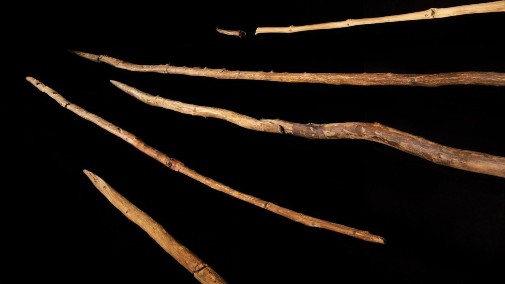Scientists have analysed amino acids locked in snail shells to establish a new age for the world's oldest complete wooden hunting weapons.
 The Schöningen spears as presented at the exhibition of the "Paläon" Research Museum in Schöningen, Germany. Photo: MINKUSIMAGES. With kind permission of the copyright holder: Niedersächsisches Landesamt für Denkmalpflege (NLD)
The Schöningen spears as presented at the exhibition of the "Paläon" Research Museum in Schöningen, Germany. Photo: MINKUSIMAGES. With kind permission of the copyright holder: Niedersächsisches Landesamt für Denkmalpflege (NLD)
According to an international study, the world-famous Schöningen spears, unearthed in Schöningen, Germany, are 100,000 years younger than previously thought and have now been revised to around 200,000 years-old.
The study used recent advances in a dating method known as "amino acid geochronology" – a technique refined by a research group led by Professor Kirsty Penkman at the University of York.
By analysing amino acids locked within snail shells buried within the sediment that preserved the spears, the research team was able, for the first time, to directly date material from the exact layer of earth in which the spears were found.
At the time of the discovery of the first spears in the mid-1990s, they were thought to be around 400,000 years-old, but that estimate was later revised to approximately 300,000 years. However, these age estimates were based on analysis of the underlying sediment layers.
The researchers, whose findings are published in the journal Science Advances, emphasise that this younger age estimate does not diminish the importance of the Schöningen discoveries. Instead, they say it further highlights the site's importance as a marker in the study of human evolution.
Sophisticated hunting strategies
Co-author of the paper, Professor Kirsty Penkman, from the Department of Chemistry at the University of York, said: "This new dating evidence places the remarkable Schöningen spears within the Middle Palaeolithic period, the time of the Neanderthals."
First author Dr. Jarod Hutson of the Leibniz Zentrum für Archäologie (LEIZA) in Mainz, Germany, said "The Schöningen spears are so significant because, unlike older sites, they offer compelling evidence of sophisticated hunting strategies which would have required better cognitive abilities and the development of more complex communication, planning and social structures. The updated timeline for Schöningen now aligns it with a growing number of sites which together indicate a significant leap in early human hunting capabilities during this period."
Exceptional preservation
The site at Schöningen, Lower Saxony, was located at a lakeside where rapid sedimentation caused the exceptional preservation of organic materials, including the impressive arsenal of hunting weapons and other wooden implements, along with the butchered remains of hunted prey, which primarily consisted of horses.
Previous archaeological investigations analysing these horse remains, notably by the MONREPOS Archaeological Research Centre and Museum for Human Behavioural Evolution near Neuwied, a LEIZA department closely linked to the Johannes Gutenberg University in Mainz, have revealed evidence of seasonal hunting of small groups of horses along the shores of the ancient lake, with over 50 individual animals documented.
These findings point towards well-organised hunting parties, where individuals undertook coordinated and specific roles to ensure successful kills of larger and more challenging prey. The redating of the Schöningen site implies a notable increase in the level and complexity of human cooperation by approximately 200,000 years ago.
Biochemical approach
Amino acid geochronology - the biochemical approach central to the redating of the site - takes advantage of the fact that amino acids, the building blocks of protein, come in two forms: left-handed and right-handed versions of the same molecule.
When a creature is alive, its proteins are made only of the "left-handed" version. But after it dies, some of these slowly change into the "right-handed" version. By measuring how much of each version is left in certain fossils, scientists can work out how long ago that creature lived. The researchers looked at the tiny "trapdoors" (called opercula) of small freshwater snails called Bithynia. These little doors are made of a mineral that traps the amino acids inside for millions of years, like a perfect time capsule. The scientists took samples of these snail trapdoors from the same layer of earth where the famous spears were found.
They compared the amounts of the two types of amino acids in the opercula from Schöningen with those from other opercula found across northern Europe. Another research team in Madrid carried out further tests on horse teeth and tiny organisms called ostracods also found in the same sediment layer, and the results backed up the idea that the Schöningen site is younger than previously thought.
Long-held secrets
Co-author of the study, Ellie Nelson, a PhD student in the Department of Chemistry at the University of York added: "Groundbreaking refinements in amino acid geochronology are allowing us to date Palaeolithic archaeological sites with greater accuracy than ever before, reshaping our understanding of this pivotal era in human history.
"This innovative method allows us to measure time signals trapped within the crystals of fossilised shell and tooth enamel in any part of the world across a range of archaeological sites. The enhanced accuracy holds immense potential for unlocking the long-held secrets of the Palaeolithic."
Further information:
The study was carried out by researchers from the University of York (UK), Leibniz Zentrum für Archäologie (Germany), National Museum of Natural History (Washington D.C), Lower Saxony Institute for Historical Coastal Research (Germany), University of Bremen (Germany), Johannes Gutenberg University Mainz (Germany), Museum of Prehistory and Archaeology of Cantabria (Spain), Universidad Politécnica de Madrid (Spain), Lund University (Sweden), Max Planck Institute for Evolutionary Anthropology (Germany), University of the Basque Country (Spain) and Complutense University of Madrid (Spain).
The amino acid dating at York was thanks to funding from the European Research Council (ERC) under the European Union's Horizon 2020 research and innovation programme (grant agreement No. 865222 - EQuaTe).





.jpg)





